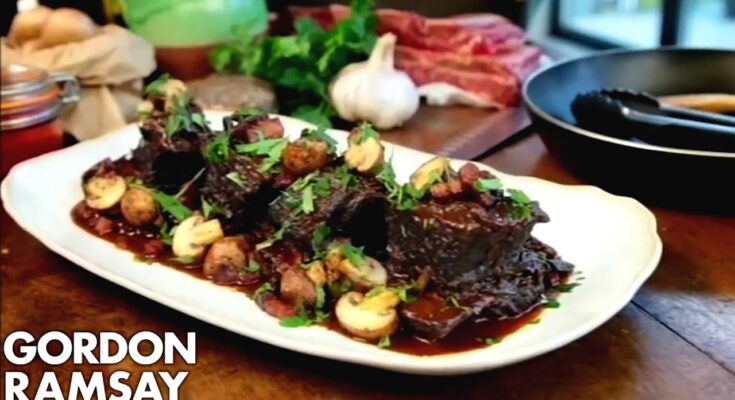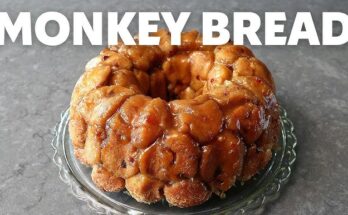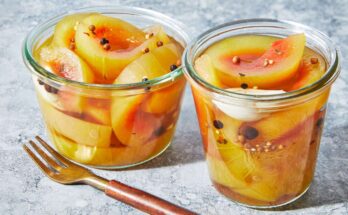Boneless Short Ribs Recipe: Short ribs are the kind of dish that speaks to the soul—rich, hearty, and oh-so-satisfying. But if you’ve only ever seen bone-in short ribs, you’re in for a treat. Boneless short ribs are just as flavorful, but they’re easier to eat and quicker to cook. This guide will walk you through a foolproof way to make boneless short ribs that are fall-apart tender, juicy, and packed with deep, savory flavor. Whether you’re cooking for a special dinner or just want to upgrade your comfort food game, this step-by-step guide will help you nail it.
Introduction to Boneless Short Ribs
Boneless short ribs are essentially the same cut as traditional short ribs but without the bone. Typically cut from the chuck or plate section of the cow, this meat is rich in marbling, making it ideal for slow-cooking methods that break down the connective tissue and result in melt-in-your-mouth goodness.
Why are they popular? For one, they eliminate the mess of bones, making them easier to serve and eat. They’re also incredibly versatile—you can braise them in the oven, slow cook them in a crockpot, or even pressure cook them for a faster meal. Their intense beefy flavor is complemented by everything from red wine to barbecue sauce. And the best part? They’re easy enough for weeknight dinners but impressive enough for guests.
Ingredients You’ll Need
Getting the ingredients right is half the battle. Here’s what you need for a classic boneless short ribs recipe that’s rich in flavor and depth:
Main Ingredients
- 2 to 3 pounds boneless beef short ribs
- Salt and freshly ground black pepper
- 2 tablespoons olive oil
- 1 onion, finely chopped
- 3 cloves garlic, minced
- 2 tablespoons tomato paste
- 1 cup beef broth
- 1 cup dry red wine (optional, but highly recommended)
- 2 tablespoons Worcestershire sauce
- 2 teaspoons fresh thyme or 1 teaspoon dried thyme
- 2 bay leaves
Optional Additions for Extra Flavor
- 1 tablespoon brown sugar (adds a subtle sweetness)
- Carrots and celery (for extra aromatics)
- Mushrooms (adds umami depth)
- A splash of balsamic vinegar (for acidity and complexity)
These ingredients work together to build a complex flavor profile that tastes like it took hours to prepare (because it kind of does, but it’s worth every minute).
Equipment Required for Cooking
Even the best ingredients can fall flat without the right tools. Here’s what you need to bring this dish to life:
Essential Kitchen Tools
- Heavy-bottomed Dutch oven or oven-safe pot with a lid
- Cutting board and sharp knife
- Measuring cups and spoons
- Wooden spoon or spatula
- Tongs (for searing the meat)
Nice-to-Have Items for Convenience
- Slow cooker or Instant Pot (for alternative cooking methods)
- Meat thermometer (to ensure perfect doneness)
- Fine mesh strainer (if you want a smoother sauce)
These tools make the process smoother, more enjoyable, and a lot less messy.
Preparing the Short Ribs
This is the foundation of your dish, so don’t rush it. Proper prep ensures every bite is flavorful and tender.
Step 1: Trimming
Start by examining your boneless short ribs. Trim off any excess fat, but don’t go overboard—you want some fat to melt during cooking and keep things juicy.
Step 2: Seasoning
Generously season both sides with salt and black pepper. This simple seasoning will help build the crust during searing and enhance the meat’s natural flavors.
Step 3: Marination Tips
While not required, marinating your ribs can enhance flavor. For a basic marinade, combine olive oil, minced garlic, thyme, Worcestershire sauce, and a splash of red wine. Let the ribs marinate in the fridge for at least 2 hours or overnight for best results.
This prep work sets the stage for deep, complex flavors that will develop during the cooking process.
Cooking Methods Explained
You’ve got options when it comes to cooking your boneless short ribs. Let’s break down the three most popular methods.
Oven-Braised Boneless Short Ribs
Oven braising is the gold standard for flavor. After searing the ribs and sautéing the aromatics, everything goes into a Dutch oven and bakes low and slow at 325°F for about 2.5 to 3 hours. The result? Fork-tender meat and a rich, glossy sauce.
Slow Cooker Boneless Short Ribs
If you’re looking for set-it-and-forget-it convenience, the slow cooker is your best friend. After searing, place everything in the slow cooker and cook on low for 8 hours or high for 4–5 hours. It’s a great option for busy weekdays.
Instant Pot Boneless Short Ribs
Pressed for time? Use the Instant Pot. After browning and adding the liquid, pressure cook on high for 45 minutes and allow a natural release for 15 minutes. It’s fast and still yields a surprisingly tender result.
Making the Perfect Braising Liquid
The braising liquid is what transforms your short ribs from average to unforgettable. This rich sauce is made from a mix of beef broth, wine, and aromatics that slowly infuse the meat with flavor as it cooks.
Building Layers of Flavor
Start by searing your seasoned short ribs in olive oil until a deep brown crust forms—this is where the flavor begins. Remove the ribs and in the same pot, sauté chopped onions, garlic, and tomato paste. The tomato paste should caramelize slightly to bring out its sweetness.
Deglaze the pan with red wine, scraping up all the browned bits from the bottom. These bits, known as “fond,” are loaded with flavor. Once the wine reduces a bit, add beef broth, Worcestershire sauce, herbs, and a touch of brown sugar if you like a hint of sweetness.
Return the ribs to the pot, ensuring they are mostly submerged in the liquid. Bring it to a simmer before transferring to the oven or slow cooker.
Braising Tips
- Always simmer gently; boiling can make the meat tough.
- Skim off any excess fat that rises to the top for a cleaner sauce.
- Taste and adjust the seasoning after cooking, especially if the sauce is too salty or acidic.
This step is essential because the sauce not only flavors the meat but also becomes a rich gravy to serve over mashed potatoes or polenta.
How Long to Cook Boneless Short Ribs
Timing is everything when it comes to tender short ribs. The goal is to break down the collagen in the meat, transforming it into gelatin that creates a silky texture.
Oven
Cook at 325°F for 2.5 to 3 hours. Check at the 2-hour mark to ensure the meat is not drying out. Add a splash of broth if necessary.
Slow Cooker
Cook on low for 8 hours or on high for 4 to 5 hours. The low-and-slow method is preferred for best texture.
Instant Pot
Pressure cook for 45 minutes, followed by a 15-minute natural release. The result is fall-apart tender meat in a fraction of the time.
Signs of Doneness
- The meat should shred easily with a fork.
- It should be deeply browned and visibly tender.
- The internal temperature should be around 195°F to 205°F for that perfect pull-apart texture.
Consistency is key, so make sure to follow the time and temperature guidelines closely to avoid over- or undercooked ribs.
Serving Suggestions for Boneless Short Ribs
Now that you’ve nailed the cooking part, it’s time to think about how to serve your masterpiece. Boneless short ribs pair well with hearty sides that can stand up to their bold flavor.
Perfect Pairings
- Mashed Potatoes: Creamy mashed potatoes are a classic choice. They soak up the sauce beautifully and complement the richness of the meat.
- Polenta: Buttery polenta is a slightly lighter alternative that still delivers on comfort.
- Roasted Vegetables: Try carrots, Brussels sprouts, or parsnips roasted until caramelized.
- Crusty Bread: Great for sopping up that luxurious sauce.
Garnishes
Top with fresh parsley for a pop of color and brightness. A sprinkle of grated Parmesan or a drizzle of balsamic glaze can elevate your dish even more.
Wine Pairing
A robust red wine like Cabernet Sauvignon or Syrah is perfect for balancing the richness of the dish.
Storing and Reheating Tips
You made a big batch—great! Short ribs actually taste better the next day after the flavors have had more time to meld.
Storage
- Let the ribs cool completely before storing.
- Transfer to an airtight container and refrigerate for up to 4 days.
- For longer storage, freeze in a sealed container or freezer bag for up to 3 months.
Reheating
- Stovetop: Reheat gently in a saucepan over low heat, adding a splash of broth if the sauce has thickened.
- Microwave: Use medium power and heat in 1-minute increments, stirring between each round.
- Oven: Place ribs and sauce in an oven-safe dish, cover with foil, and heat at 300°F for about 20 minutes.
Avoid overheating, which can dry out the meat. Always reheat until just warmed through.
Common Mistakes to Avoid
Even seasoned cooks can run into trouble with short ribs. Here are the top mistakes to avoid:
Skipping the Sear
Searing adds depth and texture. Don’t skip it, even if you’re in a rush. That brown crust is pure umami gold.
Not Deglazing the Pan
The browned bits left after searing are essential. Use wine or broth to scrape them up and build your sauce.
Cooking at Too High a Temperature
Whether in the oven or slow cooker, low and slow is the mantra. High heat can make the meat tough and the sauce overly reduced.
Overcrowding the Pot
Give the ribs space to sear properly. Cook in batches if necessary.
Neglecting to Taste the Sauce
Your sauce is half the dish. Taste and adjust the seasoning after cooking—sometimes it needs a bit more salt, acidity, or sweetness.
How to Thicken the Sauce
A rich, velvety sauce can make or break your boneless short ribs. After the meat is tender and the braising liquid has reduced, it’s time to perfect the texture of your sauce.
Reduce It Down
The most natural way to thicken your sauce is by reducing it. After removing the short ribs from the pot, place the braising liquid over medium-high heat and simmer uncovered. Stir occasionally and let it cook until it thickens to your desired consistency. This can take 10–20 minutes, depending on the amount of liquid left.
Use a Slurry
If you’re short on time, a cornstarch slurry works wonders. Mix 1 tablespoon of cornstarch with 2 tablespoons of cold water. Stir it into the simmering sauce, and cook for a few minutes until it thickens. Be careful not to add too much or it can get gloopy.
Add a Roux
For a more luxurious finish, make a quick roux by melting 1 tablespoon of butter and whisking in 1 tablespoon of flour. Stir that into your sauce and cook for another 5–10 minutes until thick and smooth.
Final Touches
Don’t forget to strain your sauce if you want a silky-smooth texture. Then, taste it. A pinch of salt, a crack of pepper, or a splash of vinegar can take it from good to unforgettable.
Variations of Boneless Short Ribs
Once you’ve mastered the classic version, why not have a little fun with it? Boneless short ribs are versatile, and the base recipe can be adapted to suit different cuisines and flavors.
Asian-Style Short Ribs
Swap out the red wine for soy sauce and beef broth. Add ginger, sesame oil, hoisin sauce, and a dash of rice vinegar. Garnish with scallions and sesame seeds. Serve with rice or steamed buns for a delicious twist.
Mexican-Inspired Short Ribs
Season your short ribs with cumin, chili powder, and smoked paprika. Braise in a mixture of tomatoes, onions, garlic, and chipotle peppers in adobo sauce. These are excellent for tacos or burrito bowls.
Italian Braised Short Ribs
Add oregano, basil, crushed tomatoes, and a splash of balsamic vinegar. Serve over creamy polenta or tagliatelle pasta with a sprinkle of Parmesan cheese.
Sweet and Spicy BBQ Ribs
For a backyard-friendly version, braise your ribs in a mix of BBQ sauce, honey, and hot sauce. Finish under the broiler for a sticky, caramelized glaze.
Experimenting with these variations lets you enjoy boneless short ribs in different styles and keeps the dish exciting every time.
Boneless vs Bone-In Short Ribs
So, what’s really the difference between boneless and bone-in short ribs? Here’s a breakdown to help you understand the distinctions and when to use each.
Flavor
Bone-in ribs can offer slightly more flavor thanks to the marrow in the bone. However, boneless short ribs are just as rich when cooked properly, especially with a flavorful braising liquid.
Texture
Boneless short ribs cook more evenly and are easier to cut and serve. Bone-in versions, on the other hand, often require more careful handling to remove the bones without losing the meat’s integrity.
Ease of Use
Boneless ribs are easier to prep, marinate, and serve. They also tend to be a bit quicker to cook since you don’t have to work around the bone.
Availability
Boneless short ribs are easier to find in many grocery stores and are often a more convenient choice for home cooks.
Both cuts are delicious, but boneless short ribs are the go-to for simplicity and convenience—perfect for both beginners and busy cooks.
Tips for Buying the Best Boneless Short Ribs
Not all short ribs are created equal. Choosing the right cut of meat makes a big difference in the final dish.
Look for Marbling
Fat equals flavor. Choose ribs with visible marbling—those white streaks of fat running through the meat. They melt during cooking and keep the meat juicy.
Ask the Butcher
If the packaging isn’t clear, ask your butcher for boneless short ribs from the chuck or plate. These are more flavorful and tender than leaner cuts.
Avoid Pre-Cut Stew Meat
Sometimes labeled as “boneless short ribs,” pre-cut stew meat can be too lean and won’t yield the same rich results. Stick to solid pieces you can cut yourself.
Go for Fresh Over Frozen
Fresh ribs tend to have better texture. If you buy frozen, let them thaw slowly in the fridge to maintain moisture and structure.
Size Matters
Choose pieces that are uniform in size so they cook evenly. About 4 to 6 inches in length and 1 to 1.5 inches thick is ideal.
Making the right choices at the butcher counter is the first step toward a show-stopping meal.
How to Make Ahead and Freeze
Short ribs are a perfect make-ahead dish because the flavors deepen overnight. They also freeze beautifully for future meals.
Making Ahead
Cook your short ribs completely, let them cool, and then refrigerate them in the sauce. The next day, skim off any solidified fat and gently reheat on the stove or in the oven.
Freezing Tips
- Freeze in airtight containers with the sauce.
- Use within 3 months for best quality.
- Label with the date and reheating instructions.
Reheating from Frozen
- Thaw overnight in the fridge.
- Reheat gently over low heat, adding a bit of broth if the sauce has thickened too much.
This make-ahead flexibility makes boneless short ribs an excellent option for meal prep, special occasions, or surprise guests.
Health Benefits of Boneless Short Ribs
While boneless short ribs are definitely an indulgent meal, they can still be part of a balanced diet when enjoyed in moderation and prepared thoughtfully.
Rich in Protein
Beef short ribs are an excellent source of high-quality protein. Protein is essential for muscle repair, hormone production, and supporting your immune system.
Packed with Nutrients
Short ribs also provide important vitamins and minerals, including:
- Iron – Helps prevent anemia and keeps your energy levels high.
- Zinc – Supports immune function and wound healing.
- Vitamin B12 – Crucial for nerve health and energy metabolism.
Collagen and Gelatin
When slow-cooked, the collagen in short ribs breaks down into gelatin, which is known to support joint health and digestion. It’s one reason the texture of short ribs is so unique and satisfying.
Tips for Healthier Cooking
- Trim excess fat before cooking to reduce calories.
- Use low-sodium broth and minimal added salt.
- Load up on vegetables like carrots, mushrooms, and celery in your braise for added fiber and nutrients.
While not diet food, boneless short ribs can be a nutrient-rich comfort dish that delivers both taste and benefits.
Serving Boneless Short Ribs for Special Occasions
Boneless short ribs are not just for cozy weeknight dinners—they can also be the centerpiece of an unforgettable meal for guests or holiday celebrations.
Impress Your Guests
With their deep flavor and beautiful presentation, short ribs feel gourmet but are deceptively easy to make. Serve them over a luxurious base like truffle mashed potatoes or creamy risotto, and you’ve got a dish worthy of a fine dining restaurant.
Elegant Plating Tips
- Slice the ribs into even portions.
- Spoon the thickened sauce generously over the top.
- Add a sprig of fresh herbs or microgreens for a pop of color.
- Serve with a bold red wine to elevate the experience.
Perfect for Holidays
Whether it’s Christmas, New Year’s, or a dinner party, short ribs are always a hit. Their rich aroma fills the kitchen, setting the stage for a memorable gathering.
Hosting made easy—short ribs can be made ahead and reheated with no loss of flavor or texture, freeing you up to enjoy your guests.
FAQs About Boneless Short Ribs Recipe
Q1: What are boneless short ribs?
Boneless short ribs are flavorful cuts of beef taken from the chuck or plate area. Unlike traditional short ribs, they don’t contain the bone, making them easier to cook and serve.
Q2: Can I cook boneless short ribs in the oven?
Yes! Oven-braised boneless short ribs are incredibly tender. Slow-cook them at a low temperature (around 300°F/150°C) for 2.5 to 3 hours for best results.
Q3: What’s the best way to make boneless short ribs tender?
Low and slow cooking is key. Braising the ribs in liquid (like beef broth, wine, or a mix) helps break down the fibers and create melt-in-your-mouth texture.
Q4: Can I use a slow cooker for this recipe?
Absolutely! Cook on low for 6–8 hours or on high for about 4 hours. The result is juicy, fall-apart beef with deep flavor.
Q5: What should I serve with boneless short ribs?
They pair well with mashed potatoes, creamy polenta, garlic rice, roasted vegetables, or even buttered noodles.
Q6: Can I freeze leftover boneless short ribs?
Yes, they freeze well. Store in an airtight container for up to 3 months. Reheat gently to retain moisture and flavor.
Q7: Do boneless short ribs taste different from bone-in short ribs?
They offer the same rich, beefy flavor, though some say bone-in ribs have a slightly deeper taste due to the marrow.
Conclusion
Boneless short ribs are the ultimate comfort food: rich, flavorful, and incredibly satisfying. With the right ingredients, techniques, and a little patience, you can transform a humble cut of beef into a dish that’s nothing short of spectacular. Whether you’re braising them for a holiday dinner or tossing them in the slow cooker on a chilly evening, they’re sure to please every time. Remember, great food isn’t just about following a recipe—it’s about making it your own. So take this guide, put your own spin on it, and enjoy every tender, juicy bite.



